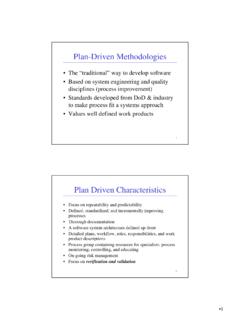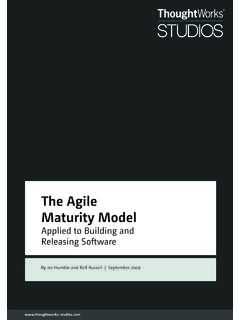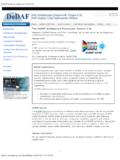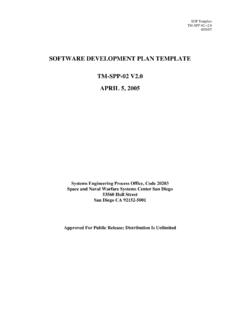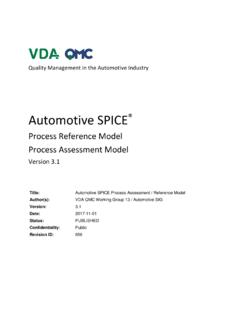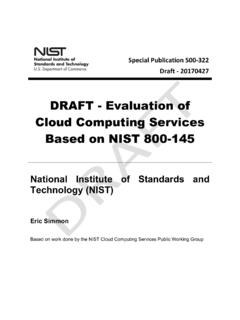Transcription of Industrie 4.0 Maturity Index - acatech
1 acatech STUDYG nther Schuh, Reiner Anderl,J rgen Gausemeier, Michael ten Hompel,Wolfgang Wahlster (Eds.) Industrie Maturity Index Managing the Digital Transformation of Companiesacatech STUDYI ndustrie Maturity Index Managing the Digital Transformation of CompaniesG nther Schuh, Reiner Anderl,J rgen Gausemeier, Michael ten Hompel,Wolfgang Wahlster (Eds.)This series comprises reports presenting the results of projects carried out by the National Academy of Science and Engineering. The studies are intended to provide informed assessments and future-oriented advice for policymakers and previous acatech publications are available for download from: acatech STUDY seriesContentsForeword 5 Executive Summary 7 Project 81 Introduction 102 Objective and methodology Methodological approach The acatech Industrie Maturity Index 143 Design of the acatech Industrie Maturity Index Value-based development stages Stage one: Computerisation Stage two: Connectivity Stage three: Visibility Stage four: Transparency Stage five: Predictive capacity Stage six.
2 Adaptability General model design 184 Industrie capabilities for businesses Resources Digital capability Structured communication Conclusion Information systems Self-learning information processing Information system integration Conclusion Organisational structure Organic internal organisation Dynamic collaboration within the value network Conclusion Culture Willingness to change Social collaboration Conclusion 355 Functional areas in the business Development Production Logistics Services Marketing & Sales 426 Application of the acatech Industrie Maturity Index Principles of application Quantify the benefits Example application in a company 497 Conclusion 51 References 525 ForewordForewordBusinesses and policymakers alike recognise the huge opportuni-ties for growth offered by digitalisation, interconnectedness and new manufacturing technologies.
3 Together, these phenomena are driving new business models, sustainable and efficient use of limited resources and the cost-effective production of highly cus-tomisable products. These developments are collectively referred to under the term Industrie , denoting an unprecedented transformation in industry, flexibility and have been numerous studies exploring companies atti-tudes towards this digital transformation and the opportunities and main obstacles associated with it. The latter are rarely con-fined to a lack of the relevant technologies or standards. In many cases, the faltering implementation of Industrie is due to rigid organisational structures that have grown up organically and a conservative culture where people lack the courage to do things differently. Our ongoing experience with the implementation of lean management principles since the 1990s has taught us that it is not enough simply to ring the changes successful implemen-tation also requires an in-depth understanding of the organisa-tion and a widespread willingness to change among its mem-bers.
4 Just as lean production is about far more than simply preventing waste, Industrie is not merely a matter of con-necting machines and products via the Internet. This study highlights the need for this paradigm use of new technologies and the acquisition of knowledge through targeted information processing will inevitably lead to new types of work and ways of working. This will necessitate changes to the structures within companies and the relation-ships between companies. The ability to analyse the prevailing corporate culture and existing patterns of thinking will thus be critical to success. Accordingly, the key challenges for business-es include understanding what Industrie means to them and systematically developing a corresponding implementation strategy. This study focuses on these aspects as well as on the requirements of Industrie in terms of information technolo-gy and resources. The acatech Industrie Maturity Index is an outstanding example of acatech s mission to promote cooperation between academia and industry.
5 An interdisciplinary consortium of research institutions in different fields worked with partners from industry across every part of the industrial value chain to develop a methodology for establishing manufacturing companies cur-rent Industrie Maturity stage and identifying areas where further action is required. This systematic identification of weak-nesses and opportunities provides the basis for formulating an implementation strategy. In short, this acatech STUDY offers manufacturing companies practical guidance for developing an individual Industrie implementation strategy that is aligned with their business strategy. We hope you enjoy reading Kagermann President acatech 7 Executive SummaryExecutive SummaryThe term Industrie has been used since 2011 to describe the widespread integration of information and communication technology in industrial manufacturing. However, it is not enough to address the developments associated with the fourth industrial revolution from just a technological perspective companies also need to transform their organisation and cul-ture.
6 While advanced technologies do make it possible to access a much wider range of data, the ability to leverage the underly-ing potential of this data is just as dependent on a company s organisational structure and culture. The ultimate goal is to be-come a learning, agile company capable of continuous, agile adaptation to a changing environment. The acatech Indus-trie Maturity Index provides companies with guidance for carrying out this transformation. It comprises a six-stage maturi-ty model in which the attainment of each development stage delivers additional benefits. The acatech Industrie Maturity Index focuses on four key ar-eas, each of which has two fundamental principles attached to it. The main challenge for companies wishing to implement Industrie is to put these principles into practice by develop-ing the various capabilities described in this study. The goal is to generate knowledge from data in order to transform the compa-ny into a learning, agile organisation and enable rapid deci-sion-making and adaptation processes throughout every part of the business and across all business process areas.
7 The acquisi-tion of this agility provides companies with a significant compet-itive advantage in a disruptive capabilities outlined in the model were aligned with the challenges and current activities of manufacturing companies and the applicability of the model was validated in practical ap-plication scenarios. This served to confirm the model s principles and to highlight the fact that companies are currently not focus-ing enough on the full implications in their strategic thinking. Many organisations still lack a basic understanding of the key aspects of Industrie For instance, companies often wrongly limit Industrie to digitalisation or full automation. Moreover, rather than pursuing a common goal, many actions that have been implemented are isolated and standalone measures. The acatech Industrie Maturity Index can be used to develop a digital roadmap precisely tailored to the needs of each individu-al company in order to help them make the most of Industrie and transform themselves into learning, agile management Prof.
8 G nther Schuh/RWTH Aachen University/ acatech Executive Board memberProject group Prof. Reiner Anderl, Department of Computer Integrated Design (DiK), Technische Universit t Darmstadt/ acatech Prof. J rgen Gausemeier, Heinz Nixdorf Institute, University of Paderborn/ acatech Executive Board member Prof. G nther Schuh, RWTH Aachen University/ acatech Executive Board member Prof. Dr. Michael ten Hompel, Fraunhofer Institute for Material Flow and Logistics IML, TU Dortmund University/ acatech Prof. Dr. Dr. mult. Wolfgang Wahlster, German Research Center for Artificial Intelligence, DFKI/acatechConsortium partners/project team Dr. Tilman Becker, German Research Center for Artificial Intelligence, DFKI Dr. Anselm Blocher, German Research Center for Artificial Intelligence, DFKI Isabel B cker, Graduate School of Logistics, TU Dortmund University Marvin Drewel, Heinz Nixdorf Institute, University of Paderborn Andreas Faath, Computer Integrated Design, Technische Universit t Darmstadt Tobias Harland, FIR e.
9 V. at RWTH Aachen University Mario Hermann, TU Dortmund University Gerd Herzog, German Research Center for Artificial Intelligence, DFKI Dr. Philipp Jussen, FIR e. V. at RWTH Aachen University Ulrike Krebs, FIR e. V. at RWTH Aachen University Maximilian Lukas, FIR e. V. at RWTH Aachen University Benedikt Moser, FIR e. V. at RWTH Aachen University Katrin Pitz, Computer Integrated Design, Technische Universit t Darmstadt Daniel Porta, German Research Center for Artificial Intelligence, DFKI Jan Reschke, FIR e. V. at RWTH Aachen University Sebastian Schmitz, FIR e. V. at RWTH Aachen University Moritz Schr ter, FIR e. V. at RWTH Aachen University Moritz Weber, Computer Integrated Design, Technische Universit t Darmstadt Lucas Wenger, FIR e. V. at RWTH Aachen University Thorsten Westermann, Fraunhofer Institute for Mechatronic Systems Design IEM Violett Zeller, FIR e. V. at RWTH Aachen UniversityProject coordination Christian Hocken, FIR e. V. at RWTH Aachen University Dr.
10 Alexander Werbik, acatech Office Dr. Johannes Winter, acatech Office Experts Ulrich Ahle, Atos IT Solutions and Services GmbH Dr. Sebastian Busse, UNITY AG Prof. Roman Dumitrescu, it s OWL Clustermanage-ment GmbH Nampuraja Enose, Infosys Ltd. Kent Eriksson, PTC Inc. Dr. Ursula Frank, Beckhoff Automation GmbH & Co. KG Dr. Bertolt G rtner, T V S D AG Markus Hannen, PTC Inc. Dr. Florian Harzenetter, PTC Inc. Dr. Andreas Hauser, T V S D Asia Pacific Pte. Ltd Craig Hayman, PTC Inc. Howard Heppelmann, PTC Inc. Claus Hilger, HARTING IT System Integration GmbH & Co. KG Ulrich Kreitz, itelligence AG David Kronm ller, T V S D Industrie Service GmbH Dr. Ravi Kumar G. V. V., Infosys Ltd. Udo Lange, itelligence AG Dr. Jan Stefan Michels, Weidm ller Interface GmbH & Co. KG Jeff Miller, PTC Inc. Gordon M hl, Infosys Ltd. Prof. Boris Otto, Fraunhofer Institute for Software and Systems Engineering ISST, TU Dortmund University Felisa Palagi, PTC Inc. Dr. Thomas Roser, PTC Inc.
